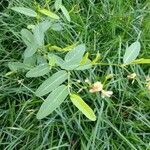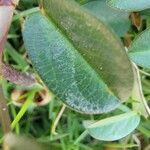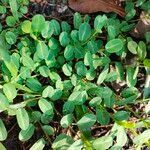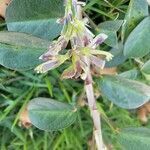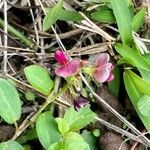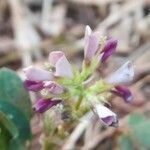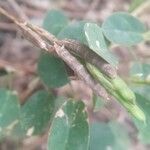Erect or spreading procumbent perennial herb, woody at the base, 10-60 cm tall. Stems densely to sparsely pubescent or puberulous, at length ± glabrous. Leaves 1-foliolate; leaflet 0.5-6.5 x 0.3-2.6 cm, ovate, oblong, oblong-elliptic or lanceolate, acute to emarginate and mucronulate at the apex, subcordate at the base, finely puberulous and with longer hairs, or almost glabrous on upper surface, ciliate; reticulation prominent on both surfaces; petiole 4-15 mm long; petiolule 1-2 mm long; stipules 7-17(24) mm long, lanceolate. Inflorescences terminal and leaf-opposed, 2-13 cm long, mostly dense, the internodes mostly shorter than the flowers, glabrous or usually densely pubescent; peduncle 0-5 cm long; rhachis 2-13 cm long; pedicels 0.5-2 mm long; primary bracts 4-8 x 1.5-2.5 mm, ovate-lanceolate to lanceolate, acuminate, ± glabrous, deciduous; secondary bracts similar, 2.5-3.5 mm long. Calyx puberulous or pubescent; tube 1.5-2.5 mm long; teeth 3-4 x 0.5-1 mm, narrowly triangular, acuminate, not imbricate. Standard orange, pinkish-buff or purple, often paler than other petals, 4-6 x 3-4 mm; wings mauve; keel magenta, mauve or green with purple tip. Fruit 1.2-2.5 cm long, well exserted from the calyx, not constricted between the articles; articles 4-7, 2.5-3 x 1.5-3 mm, subcylindrical, with raised reticulate ridges, puberulous with uncinulate hairs. Seeds yellowish, speckled brown or entirely yellow-brown, slightly compressed, 1.7 x 1.5 x 1 mm, ellipsoidal.
Herbs, suberect to prostrate, to 0.5 m tall; stems straw colored to black, glabrescent. Leaves unifoliolate, elliptic-orbicular, to 2.5 cm long, ca. 1.5 cm wide, apex rounded, apiculate, obtuse, truncate or subcordate basally, drying green, glabrous above, strigose-villose beneath; stipules erect, often amplexicaul, subulate, to 1.5 cm long, ca. 2 mm wide basally, acute, scarious, ciliolate. Inflo-rescence racemose, terminal, to 10 cm long. Flowers purple, ca. 5 mm long; the calyx deeply 5-lobed, the lobes unequal, acuminate, striate, puberulent; the stan-dard obovate, ca. 5 mm long; the wings oblong, ca. 4 mm long, the claw ca. 1.5 mm long, the keel connivent, oblong, ca. 4 mm long; stamens diadelphous, the staminal sheath terete, to 7 mm long, ca. 0.6 mm wide, the filaments alternating in length, the longer filament to 0.6 mm long, the anthers rotund, ca. 0.3 mm long; ovary linear, ca. 3 mm long, ca. 0.5 mm wide, appressed villosulose, the style compressed, geniculate, swollen, the stigma subdiscoidal, truncate. Fruits strongly ascending, terete, drying black, puberulent, ca. 6-articulate, articles ca. 2 mm long; seeds ca. 2 mm long, suborbicular, lustrous, reddish brown.
Herbs, perennial. Stem erect or procumbent, 30-90 cm tall, glabrous or slightly pubescent. Leaves 1-foliolate; petiole 5-14 mm, glabrous; blade often ovate-oblong or oblong-lanceolate to lanceolate, to 6.5 × 1-2 cm on upper stem, cordate, nearly orbicular, or ovate, 1-3 × ca. 1 cm on lower stem, abaxially slightly pubescent, adaxially glabrous. Racemes axillary or terminal, 1.5-7 cm, 6-12-flowered, binate at each node; internodes 2-5 mm. Pedicel 3-4 mm. Calyx 5-6 mm, slightly longer than first article of legume. Corolla red, reddish purple, purplish blue, or yellow, slightly longer than calyx, ca. 5 mm; standard obovate. Ovary pubescent, 4-7-ovuled. Legume compressed, cylindric, 1.5-2.5 cm × 2-2.5 mm, pubescent, 4-7-jointed, not constricted between articles, with raised linear ridges. Seeds ellipsoidal, slightly compressed. Fl. Sep, fr. Sep-Nov. 2n = 14, 16.
A spreading low lying shrub or herb. It has many stems. They are 10-60 cm long. These spread out from a rootstock which continues to live from year to year. The leaf has one leaflet. The leaflet is oblong or sword shaped and 0.5-6.6 cm long by 0.3-2.6 cm wide. The leaflets are dark green above and pale underneath. They are oval and have netted veins. They can be notched or with a tip at the end. The flowers are small and not easily seen. They are 6 mm long at the ends of branches. The flowers occur in clusters 2-13 cm long. The flower colour varies. The pods are deep red and not quite round. They stick upwards. They contain 4-7 seeds. The seeds are brown and sometimes they are mottled.
Leaves 1-foliolate; leaflet 0.5–6.5 × 0.3–2.6 cm, ovate, oblong, oblong-elliptic or lanceolate, acute to emarginate and mucronulate at the apex, subcordate at the base, finely puberulous and with longer hairs, or almost glabrous on upper surface, ciliate; reticulation prominent on both surfaces; petiole 4–15 mm long; petiolule 1–2 mm long; stipules 7–17(24) mm long, lanceolate.
Inflorescences terminal and leaf-opposed, 2–13 cm long, mostly dense, the internodes mostly shorter than the flowers, glabrous or usually densely pubescent; peduncle 0–5 cm long; rhachis 2–13 cm long; pedicels 0.5–2 mm long; primary bracts 4–8 × 1.5–2.5 mm, ovate-lanceolate to lanceolate, acuminate, ± glabrous, deciduous; secondary bracts similar, 2.5–3.5 mm long.
Caule pube brevi sabscabro, foliis basi subcordatis ovalibus oblongisve mucronulatis glabris margine et nervo medio subpubentibus, stipulis petioli longitudine, legumine teretiusculo reticalato 4-5-articulato calyce multo longiore subpubescente.
Fruit 1.2–2.5 cm long, well exserted from the calyx, not constricted between the articles; articles 4–7, 2.5–3 × 1.5–3 mm, subcylindrical, with raised reticulate ridges, puberulous with uncinulate hairs.
Standard orange, pinkish-buff or purple, often paler than other petals, 4–6 × 3–4 mm; wings mauve; keel magenta, mauve or green with purple tip.
Calyx puberulous or pubescent; tube 1.5–2.5 mm long; teeth 3–4 × 0.5–1 mm, narrowly triangular, acuminate, not imbricate.
Seeds yellowish, speckled brown or entirely yellow-brown, slightly compressed, 1.7 × 1.5 × 1 mm, ellipsoidal.
Erect or spreading procumbent perennial herb, woody at the base, 10–60 cm tall.
Stems densely to sparsely pubescent or puberulous, at length ± glabrous.
Herb about 6 in. high, ascending
Cylindrical wrinkled fruits.
Small reddish flowers
